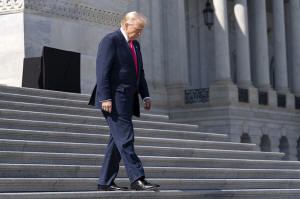Federal judge appears skeptical probationary firings were for
performance
[March 13, 2025]
By BRIAN WITTE
BALTIMORE (AP) — A federal judge repeatedly sounded skeptical on
Wednesday that the Trump administration’s mass firings of probationary
federal workers were made by the government because the employees
couldn’t do their jobs, saying the terminations appeared to be part of a
larger goal.
U.S. District Judge James Bredar made the comments at a hearing where
nearly 20 states are seeking a temporary restraining order to stop any
more firings of federal probationary employees and to reinstate those
who have already been dismissed. If the dismissals were part of a
large-scale reduction in force, there are certain laws guiding the
process.
“This case isn’t about whether or not the government can terminate
people. It’s about if they decide to terminate people how they must do
it,” Bredar said. “Move fast and break things. Move fast, fine. Break
things, if that involves breaking the law then that becomes
problematic.”
The states argue that the Trump administration blindsided them by
ignoring laws set out for large-scale layoffs, which could have
devastating consequences for their state finances. At least 24,000
probationary employees have been terminated since Trump took office, the
lawsuit alleges.
The Trump administration, on the other hand, argues that the states have
no right to try and influence the federal government’s relationship with
its own workers. President Donald Trump, a Republican, has said he’s
targeting fraud, waste and abuse in a bloated federal government.

Probationary workers have been targeted for layoffs across the federal
government because they’re usually new to the job and lack full civil
service protection. Multiple lawsuits have been filed over the mass
firings. One judge refused to block the firings in a lawsuit filed by
unions, finding that the workers needed to go through the employment law
system. Another found a memo underlying the layoffs was unlawful, but
did not immediately block the firings or reinstate workers.
This is the first lawsuit led by states and is being considered by
Bredar, a judge appointed by President Barack Obama and based in
Baltimore.
The Trump administration has brought a new perspective in terms of how
the federal government should operate, how many people should work for
the government and the work that the government should do across the
board, Bredar said.
As a result, the judge said, the administration has decided to shift
thousands of people out of federal employment, “which may well be their
prerogative.” However, Bredar noted that this case centers on how they
did it.
Bredar said the dismissals appeared to be more characteristic of a
large-scale reduction in force, rather than simply ousting probationary
workers because they could not do their jobs. Bredar said the employees
appear to have been “terminated as a group in order to achieve a broader
objective.”
[to top of second column]
|

President Donald Trump walks down the stairs after a luncheon with
the Speaker of the House Mike Johnson, R-La., and Ireland's Prime
Minister Micheal Martin at the U.S. Capitol on Wednesday, March 12,
2025, in Washington. (AP Photo/Jose Luis Magana)

While federal agencies claimed the employees were fired for
unsatisfactory performance or conduct, the lawsuit led by the state of
Maryland said the firings were part of the administration’s attempt to
restructure and downsize the entire government.
That means the administration was required to follow federal laws and
regulations that govern large-scale federal reductions in force, the
lawsuit said. For example, regulations require that government agencies
consider an employee’s tenure, performance and veteran status when
making termination decisions, the attorneys said. Regulations also
typically require 60 days’ advance notice of termination in a reduction
in force.
Virginia Williamson, a Maryland assistant attorney general, argued at a
hearing Wednesday that states are suffering “real and irreparable harm
as a result of the failure to provide notice.” That’s because states use
the information to help the unemployed find work.
“State rapid response agencies across the country need information about
the number of employees who are going to be laid off in a mass layoff
like the ones that the defendants did in order to provide information
about resources for job hiring, information about unemployment benefits,
to essentially forestall harms that could befall the state, that will
befall the state, absent of any sort of intervention,” Williamson said.
The states also will suffer financially because they will need to
support unemployed workers while contending with a sudden loss in state
income tax revenue, she said.
U.S. deputy assistant attorney general Eric Hamilton contended that the
probationary worker dismissals did not amount to a reduction in force.
“The documents that are in the record for actual federal government
employees who were terminated show that there wasn’t a (reduction in
force) and that these agencies made judgments that the probationers were
not fit for federal government service,” Hamilton said.
The other states that have joined the lawsuit are Arizona, California,
Colorado, Connecticut, Delaware, Hawaii, Illinois, Massachusetts,
Michigan, Minnesota, Nevada, New Jersey, New Mexico, New York, Oregon,
Rhode Island, Vermont, and Wisconsin. The District of Columbia also is a
plaintiff.
The judge said he planned to issue a written decision “promptly.”
All contents © copyright 2025 Associated Press. All rights reserved
 |